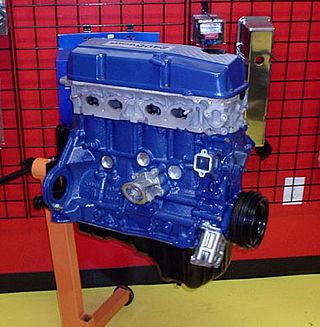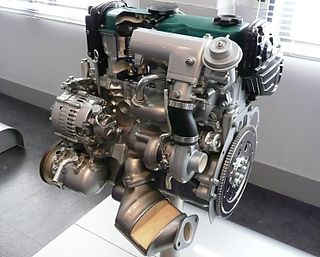
The VQ is a family of V6 automobile petrol engines developed by Nissan and produced in displacements varying from 2.0 L to 4.0 L. Designed to replace the VG series, the all-aluminium 4-valve per cylinder DOHC design debuted with Nissan's EGI/ECCS sequential multi-point fuel injection (MPFI) system. Changes from the VG engine include switching to a timing chain from a timing belt, and relocating the water pump from the outside of the engine to inside the timing cover where the pump is driven by the timing chain. Later versions featured various improvements, such as variable valve timing, and NEO-Di designated VQ engines replace MPFI with direct fuel injection.

The RB engine is an oversquare 2.0–3.0 L straight-6 four-stroke gasoline engine from Nissan, originally produced from 1985 to 2004. The RB followed the 1983 VG-series V6 engines to offer a full, modern range in both straight or V layouts.

The VG engine is a family of V6 engines designed and produced by Nissan between 1983 and 2004.

The KA engines were a series of four-stroke inline-four gasoline piston engines manufactured by Nissan, which were offered in 2.0 and 2.4 L. The engines blocks were made of cast-iron, while the cylinder heads were made of aluminum.

Toyota Motor Corporation's M family of engines were a longitudinally mounted straight-6 engine design. They were used from the 1960s through the 1990s. All M family engines were OHC designs. While the M family was born with a chain-driven single camshaft it evolved into a belt-driven DOHC system after 1980. All M family engines used a cast-iron block with an aluminum cylinder head, and were built at the Toyota Kamigo plant in Toyota City, Japan.

The CA engine is a series of 1.6 to 2.0 L Inline-4 piston engines from Nissan. It is designed for a wide variety of smaller Nissan vehicles to replace the Z engine and some smaller, four-cylinder L series engines. The "CA" stands for Clean Air, due to the installation of Nissan emission reducing technology, called NAPS-X.
The Nissan H series of automobile engines is an evolution of the Nissan "R" engine which was based on the 1.5-liter, three-main bearing "G" engine used in the 1960s. Both inline-four and inline-six versions were produced. It is a pushrod OHV design with iron block, early models with an iron head, later models with aluminum head. Versions of this motor have been used in many Nissan autos and forklifts, well into the eighties and a version called H20II was in production until 2003. The SD diesels are based on this series of motors

The Nissan L series of automobile engines was produced from 1966 through 1986 in both inline-four and inline-six configurations ranging from 1.3 L to 2.8 L. It is a two-valves per cylinder SOHC non-crossflow engine, with an iron block and an aluminium head. It was the engine of the Datsun 510, Datsun 240Z sports car, and the Nissan Maxima. These engines are known for their reliability, durability, and parts interchangeability.

The Prince G-series engine was the company's only straight-four and straight-six engines which began production in 1955. A number of variations were made, with both OHV and OHC heads. A diesel four-cylinder with 1.9 L (1,862 cc) was also built, called the D-6. The G series was used in the Skyline, the Laurel, and the Gloria from the 1950s to the early 1970s.

The Nissan Cedric is a large automobile produced by Nissan since 1960. It was developed to provide upscale transportation, competing with the Prince Skyline and Gloria which were later merged into the Nissan family. In later years, the Nissan Skyline was positioned as a sports sedan/coupe, whereas the Nissan Gloria was turned into a sporty version of the Cedric.

The Toyota UR engine family is a 32-valve dual overhead camshaft V8 piston engine series which was first introduced in 2006, as the UZ series it replaced began phasing out. Production started with the 1UR-FSE engine with D-4S direct injection for the 2007 Lexus LS. The series launched with a die-cast aluminum engine block, aluminum cylinder heads and magnesium cylinder head covers. All UR engines feature variable valve timing for both intake and exhaust cams or Dual VVT-i. Timing chains are used to drive the camshafts. The UR engine has been produced in 4.6, 5.0, and 5.7-liter displacement versions.

The MA is a straight-4 SOHC 0.9 L, 1.0 L, or 1.2 L engine first introduced in 1982 by Nissan, intended primarily for the K10 series Micra/March model. It shares design similarities with the older E engine, with an 8-valve hemispherical cylinder head but differs in that it uses an aluminium cylinder block. Unusually, the specified ignition timing for the MA10 running on the specified 90 RON gasoline was 2 degrees after top dead centre, reflecting a very high flame speed in the compact combustion chambers.

The Nissan CD engine is a diesel version of the Nissan CA engine that replaced the Nissan LD four-cylinder engine. They have a cast-iron block and alloy head. It was used from 1980 to the late 1990s until it was replaced by the Nissan YD engine.

The Nissan NA family of straight-four engines is a series of engines manufactured by Nissan. It is the replacement of the Z series, on which its design is based, and is mostly used in commercial vehicles due to its use of Liquefied petroleum gas for fuel on engines with a "P" suffix code.
The Nissan TB straight-six petrol engine was released in 1987 as the TB42. Bore and stroke were 96 mm × 96 mm. Cubic capacity was 4,169 cc displacement). The engine was released with a two-barrel carburettor and a point type distributor. It was used in the Nissan Patrol Y60 and Y61 series.

The Nissan QD engine, successor to the Nissan TD engine, was an inline four-cylinder overhead valve diesel produced from the mid-1990s through 2000, with a turbocharger used on three variants, the QD32ETi(Elgrand and Terrano) QD32T and Qd32Ti(intercooled) in Chinese Markets. It was replaced by the Nissan ZD engine.
The Nissan FD engine is used primarily for Nissan Truck and Bus commercial vehicles. It is of an inline-four layout.

The Nissan VRH engine family consists of several racing engines built by Nissan Motor Company beginning in the late 1980s. All VRH engines are in a V8 configuration, with either natural aspiration or forced induction. Some VRH engines are loosely based on Nissan's production V8 engine blocks, including the VH and VK engines, while others were designed from the ground up for racing and share no components with production blocks.















